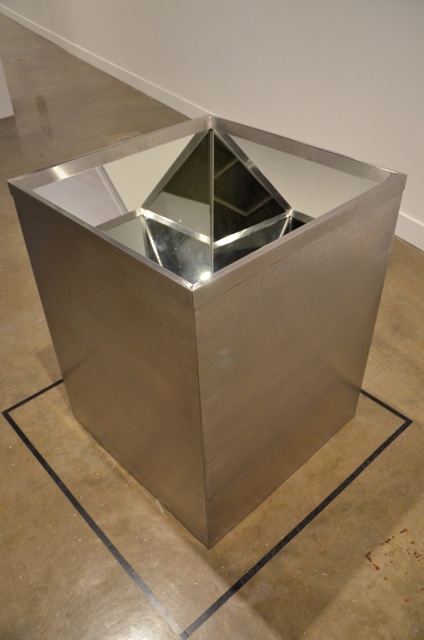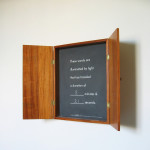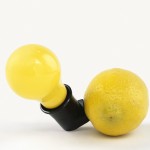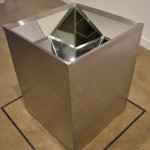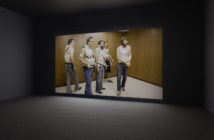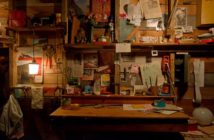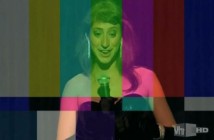The MIT List Visual Arts Center has recently concluded the excellent exhibition, In the Holocene, which proposes fascinating parallels and conditions regarding artistic and scientific speculation. Using the rubric of Robert Smithson’s artistic inquiries (his work is represented several times in the show), Big Red & Shiny contributor Ben Sloat recently spoke with the curator of the MIT LVAC, João Ribas, on the variety of ideas, artworks, and practices included in this exhibition.
•••
Ben Sloat: Robert Smithson has spoken about how when an artwork develops a commodity value, artists become estranged from their own time. One thing that struck me about this show is the reinvigoration of the sense of the artist’s time: the research and the experimentation of the artist, but also the context of history and a parallel with gallery time/experiential time.
João Ribas: The background to what you’re describing is really the horizon of the show: What is the relationship between art and science? Particularly in terms of what we commonly associate with these two ways of world making, the scientific way, and the artistic way of world making, and the explicit factors that govern these two supposedly different ways of looking at the world. We tend to think of the scientific one as empirical and positivistic, having to do with some form of veridical truth or falsifiable criteria, and the process of the repeatability of an experiment that gets formulated into a law. On the other hand you have the artistic side, which is often associated with the expressive, or affective, and more lateral kinds of thinking and feeling, and deemed antithetical to the scientific. One might associate this with the space of the qualitative rather than the quantitative. What I find interesting is that despite these supposed divisions, the conditions of these disciplines, they are actually joined together by very common ideas. Curiosity and speculation is something both art and science share, for example, along with a sense of wonder. The disruptive insight is another. But, as two different worlds of world making—to borrow Nelson Goodman’s phrase—the conclusions, the logic, the methods, in the attempt to understand the world, are very different.
What I was interested in was actually a tertiary space, a space "in between" whose value I think is often overlooked, in terms of the nature and value of artistic speculation on the world. You might want to call it "art as science," but I think of it, actually, as art as a speculative form of knowledge. I mean in the sense that the value of these propositions made by artists neither fits the criteria of scientific investigation, its veridical, empirical, positivist basis, but neither can be reduced to the aesthetic or the received museological idea of what art making is, as the creation of a contemplative, auratic, affective, or perceptive object. It seems to me there was—and this is what your question is directly alluding to—a kind of history of speculative propositions in art history itself that didn’t fit the strictures of either criteria. There are, in fact, a set of historical convergences historically that show this connection: the facility of figures like Galileo and da Vinci between the aesthetic and scientific speculation, for one, or the link between the world as described by quantum mechanics and the basic principles of surrealism—these kinds of convergences are in fact the norm from the 18th century through the 20th century. What I found is that artists are very invested in these kinds of convergences and forms of speculation, and always have been, and some, like (Joseph) Beuys, have even tried to systematize them. It’s something that they set out in an artistic mode as a set of propositions, often performed with a kind of scientific rigor. For example, the emergent picture of the world ushered in by modern physics and the beginning of what we now consider modern art involve many shared ideas about space and time—such that modernism clearly had an investigative and speculative component that goes beyond its formal concerns.
I’m interested in how artists themselves were making these kinds of propositions, in an ideational space that fits between the strictures of both disciplines: approaching scientific principles with artistic methods, as well as exploring aesthetic modalities with scientific methodology. Smithson is a classic example. The show involves returning to some of those narratives, in some cases with a very revisionist bent in art historical terms, over a very large expanse of time. The reason for this is to emphasize the idea of human understanding, of what we learn about the world through art or the aesthetic. For a long time there was a narrative about why we should look at art, the idea being that it had some kind of edifying or moralizing function, both a social, and a socializing function. Of course, the second half of the 20th century completely undid that idea, not least in how the fascistic appropriation of high art undermined the idea of any moralizing or progressive function. While this gave rise to other ideas of what good art might do socially or culturally—say in the narrative of a technological emancipation in the 1960s—what I’m interested in is to what extent there is a repressed or lost narrative running through modern art and beyond, which artists themselves sought to foreground, about the function of art as a form of investigation and speculation, a way of producing knowledge about the world.
BS: In the terms of the Enlightenment equation of the viewer gaining knowledge through their own observation, there seems to be an emphasis in this show on the analog and on human vision, even human scale, since so much of mechanized processes (on a nano or celestial level) within a digital context are hidden and unverifiable.
JR: The show is largely human scale precisely because it’s explicitly about the nature of human knowledge. So it’s concerned in particular with the idea of human scale in relation to cosmological, geological, or quantum scales: looking up at the sky, looking into the earth, looking into smaller and smaller increments of space, or time. The Holocene, as our period of geological time, itself juxtaposes these scales and temporalities: is a measure of human presence on earth in terms of geological strata, in the building up of layers, but we live in it in calendric time, the time of the everyday, the hours, days, months, and years of a human lifetime; the time of Kawara’s Day paintings, for example. Yet it is also the time in which humans have come to such significant insights about the beginnings of the universe and the origins of life, as well as the awareness that we are perhaps the worst thing to have happen to it in 3.5 billion years. So there are moments in the show where I try to link these scales together, whether in the lichen growing in Helen Mirra’s piece in relation to the satellites in geostationary orbit for millions of years in Trevor Paglen’s photograph; or the scale of geological time, or crystallographic space in Smithson. There’s a Paiva & Gusmão film in the show where you see a human figure walking, and the scale shifts so he’s basically a dot in this massive landscape. This is itself reflected in the relationship of the viewer to the scales of the art objects in the show, most of whose scale both relates to the body, but also to human labor, even while addressing these vast spans of time or ideation.
BS: You mention this exhibition’s engagement with different layers of time, the Smithson Partially Buried Woodshed photo in the show refers to a simultaneous construction/destruction scenario, but also a very resonant historical moment, the events of Kent State. He has also written about the crystallization of time, a state of equilibrium as a conception of the future. How does this show point to the future?
JR: I was interested in this ecological imaginary that seems to be a big part of contemporary culture. If you think about classic sci-fi scenarios, they tend to be about the "last man," a sort of return to an atavistic or primitive state, but in the future. The dominant scenario today seems, to me, to be totally the opposite: a post-human imagining of what the world would be like without us, not what it would be like to be the last human on earth. It’s the ecological imaginary of a world decaying after humans have disappeared. What I find fascinating is that it’s an attempt, at the same time, to projectively imagine what the future fossils will be, "what will survive?"
In a sense, the show is an attempt at imagining this too: What if the only thing that survived was an art museum, and that it got dug up by some future culture 10,000, 1 million, 2 million, 5 million, 10 million years from now? What if this art was all they found? What would they know about the human species? Would they recognize that these things were made by a human person? Would they understand the world they implied? What if art was the only source of human investigation into the world that survived? If brings up all kinds of question about deep history, and our sense of the future as a limit condition.
BS: I was thinking of the Four Sided Vortex as both a tomb and a satellite. It’s not only an object from history but it’s an object that collects history: faces, light, experiences, dust. Then it also seems to be in motion as it is approached: projecting and refracting the environment around it, and continuing in this process far past my lifetime.
JR: That goes back to that story I told you, about this child who was looking at the Smithson and said something extraordinarily beautiful about how the mirror had collected all these reflections of everyone who’s looked into it . . . it wonderfully alludes to the idea of non-anthropomorphic kinds of vision, how it changes in relationship to technological modes, but also to natural forms, as with Smithson’s interest in crystal structures, which scaled up, in essence allows us to see how the crystal sees. There’s a component in the show about thinking beyond the human in terms of degrees of experience. In Jimmy Durham’s case, to what extent is the relationship between myself as a human and an object different from that object to another object? How is my relationship to this coffee cup different from the relationship of the coffee cup to the table? This has a really wide spectrum, from the pan-psychic, to the quantum world, how the coffee cup isn’t actually sitting on the table, but actually hovering 10 to minus-8 centimeters above as electrons repel each other. That kind of thing is permeated through the show, and in that sense, returns a lot of art to its speculative and scientific roots.
One thing I think isn’t fully explored in the show, and that would be interesting to elaborate, would be to address the idea of personhood. What constitutes personhood? That is, in a sense, the threshold between the animal and human. Thinking about ways of world making, the obvious next step from the scientific to the artistic, or let’s say, the empirical to the aesthetic, is the animal, in terms of animal ways of world making—this is somewhat addressed by Germaine Kruip’s film of the bowerbird in the exhibition. Think of the world of the tick. It’s a three-order world; its whole world is based on responding to three affects.
BS: The show seems to start off with a big bang, the Sugimoto lighting.
JR: It literally starts off with a big bang! The Vantongerloo painting is about the formation of matter, the creation of matter from a single dense point of mass in space. Then, you have the spark of light in the Sugimoto, the basic building blocks of life as a photographic soup.
BS: What of the disconnect of science’s need for constant progress, always pushing forward? Art, for example, doesn’t make relics, but science constantly does.
JR: Here’s where I would slightly disagree with you, one of the things that the show tries to address, or even mimic, is how the nature of scientific discovery is not directly linear or teleological—it is certainly cumulative, but not necessarily in a linear progression in the sense that you mean. Sometimes it takes returning back to the same problems over hundreds of years or "relics" as you called them, or old ways of approaching a new problem, or problems that exist simultaneous with new discoveries. Fermat’s Last Theorem for example; or five-fold symmetry in crystals. It was received knowledge for hundreds of years that there was no such thing—or rather it was associated with mysticism for people like Kepler. In Smithson’s understanding of crystals, there was no five-fold symmetry; the Nobel Prize in chemistry was given to work on these kinds of symmetries just a few years ago. Artistic progress is equally "crystalline" lets say.
BS: One last thing I’ll mention is the interesting tension between the human drive to innovate and create, in both an artistic and scientific context, but how that might ultimately produce only destruction. Smithson has talked about construction sites that look like sites of destruction.
JR: Smithson saw this condition very clearly, both in the tailings of disused mines, and the sprawling ruins of New Jersey highways.
BS: Expressed in works of his like Island of Broken Glass.
JR: In a way, that’s Smithson’s version of Easter Island. That, and the hypothetical continents he conceived of are object lessons, warnings about our relationship to nature. When ecological disaster strikes, such as the deforestation of Easter Island, what remains is this message, this warning. Smithson really asks to think about what we’ve have lost when we see remnants or ruins. What do we lose about the understanding of that world when we lose these civilizations, when a language fades, when we lose different ways of world making? It’s a tragic kind of warning to say, "think about what will remain." What will be the future ruins of our civilization? Will it be our cities, or the vortex of plastic in the Pacific? Art does that in a way that’s both sublime and terrifying, creating striking reminders of how close we might be to losing important ways of understanding the world.
- Matthew Buckingham, Celeritas, 2009 Screened letters on a chalkboard enclosed in a wooden cabinet illuminated by natural or artificial light 27 x 22 x 4 inches Edition of 5 Courtesy of Murray Guy, New York
- Joseph Beuys, Capri-Batterie (Capri Battery), 1985 Collection Walker Art Center, Minneapolis © 2012 Artists Rights Society (ARS), New York / VG Bild-Kunst, Bonn
- Robert Smithson, Four-Sided Vortex, 1965 Courtesy The Robert Smithson Estate (James Cohan Gallery, NY)

